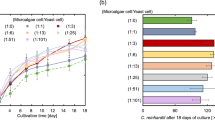Abstract
In this work, carob pulp syrup was used as carbon source in C. cohnii fermentations for docosahexaenoic acid production. In preliminary experiments different carob pulp dilutions supplemented with sea salt were tested. The highest biomass productivity (4 mg/lh) and specific growth rate (0.04/h) were observed at the highest carob pulp dilution (1:10.5 (v/v), corresponding to 8.8 g/l glucose). Ammonium chloride and yeast extract were tested as nitrogen sources using different carob pulp syrup dilutions, supplemented with sea salt as growth medium. The best results were observed for yeast extract as nitrogen source. A C. cohnii fed-batch fermentation was carried out using diluted carob pulp syrup (1:10.5 v/v) supplemented with yeast extract and sea salt. The biomass productivity was 420 mg/lh, and the specific growth rate 0.05/h. Under these conditions the DHA concentration and DHA production volumetric rate attained 1.9 g/l and 18.5 mg/lh respectively after 100.4 h. The easy, clean and safe handling of carob pulp syrup makes this feedstock a promising carbon source for large-scale DHA production from C. cohnii. In this way, this carob industry by-product could be usefully disposed of through microbial production of a high value fermentation product.


Similar content being viewed by others

References
Albergaria H, Roseiro J, Collaço MT (1999) Technological aspects and kinetic analysis of microbial gum production in carob. Agro Food Industry Hi-Tech 10:24–26
Borowitzka MA (1992) Algal biotechnology products and processes: matching science and economics. J Appl Phycol 4:267–279
De Swaaf ME, Rijk TC, Eggink G et al. (1999) Optimisation of docosahexaenoic acid production in batch cultivations by Crypthecodinium cohnii. J Biotechnol 70:185–192
De Swaaf ME, Sijtsma L, Pronk JT (2003a) High-cell density fed-batch cultivation of the docosahexaenoic acid producing marine alga Crypthecodinium cohnii. Biotechnol Bioeng 81: 666–672
De Swaaf M, Pronk JT, Sijtsma L (2003b) Fed-batch cultivation of docosahexaenoic-acid-producing marine alga Crypthecodinium cohnii on ethanol. Appl Microbiol Biotechnol 61:40–43
De Swaaf ME, Sijtsma L (2004) Biotechnological production and applications of the ω−3 polyunsaturated fatty acid docosahexaenoic acid. Appl Microbiol Biotechnol 64:146–153
Guillard RL (1960) A mutant of Chlamydomonas moewusii lacking contractile vacuoles. J Protozool 7:262–269
Guillard RL (1975) Culture of phytoplankton for feeding marine invertebrates. In: Smith WL, Chanley MH (eds) Culture of marine invertebrate animals, Plenum Press, New York, p 26
Guillard RL, Ryther JH (1962) Studies of marine planktonic diatoms. I. Cyclotella nana Hustedt and Detonula confervacea Cleve. Can J Microbiol 8:229–239
Jiang Y, Chen F, Liang S-Z (1999) Production potential of docosahexaenoic acid by the heterotrophic marine dinoflagellate Crypthecodinium cohnii. Process Biochem 34:633–637
Jiang Y, Chen F (2000a) Effects of temperature and temperature shift on docosahexaenoic acid production by the marine microalga Crypthecodinium cohnii. J Am Oil Chem Soc 77:613–617
Jiang Y, Chen F (2000b) Effects of medium glucose concentration and pH on docosahexaenoic acid content of heterotrophic Crypthecodinium cohnii. Proc Biochem 35:1205–1209
Lepage G, Roy CC (1986) Direct transesterification of all classes of lipids in a one-step reaction. J Lipid Res 27:114–119
Molina E, Fernández J, Acién FG et al. (2001) Tubular photobioreactor design for algal cultures. J Biotechnol 92:113–131
Petit MD, Pinilla JH (1995) Production and purification of a sugar syrup from carob pods: Lebensm-Wiss u-Technol 28:145–152
Ratledge C (2004) Fatty acid biosynthesis in microorganisms being used for single cell oil production. Biochemie 86:807–815
Roseiro JC, Gírio FM, Collaço MT (1991) Yield improvements in Carob sugar extraction. Process Biochem 26:179–182
Sijtsma L, Anderson A, Ratledge C (2005) Alternative carbon sources for heterotrophic production of docosahexaenoic acid by the marine alga Crypthecodinium cohnii. In: Cohen Z, Ratledge C (eds) Single cell oils, AOCS PRESS, Champaign, p 107
Tuttle RC, Loeblich AR (1975) An optimal growth medium for the dinoflagellate Crypthecodimium cohnii. Phycologia 14:1–8
Acknowledgment
The authors thank Dr. Francisco Girio (UFMB/DB/INETI) for the gift of carob pulb.
Author information
Authors and Affiliations
Corresponding author
Rights and permissions
About this article
Cite this article
Mendes, A., Guerra, P., Madeira, V. et al. Study of docosahexaenoic acid production by the heterotrophic microalga Crypthecodinium cohnii CCMP 316 using carob pulp as a promising carbon source. World J Microbiol Biotechnol 23, 1209–1215 (2007). https://doi.org/10.1007/s11274-007-9349-z
Received:
Accepted:
Published:
Issue Date:
DOI: https://doi.org/10.1007/s11274-007-9349-z



